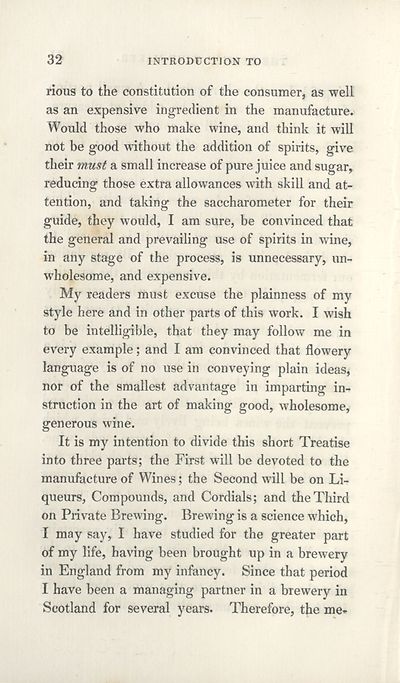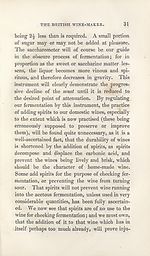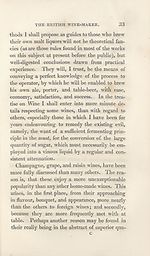Download files
Complete book:
Individual page:
Thumbnail gallery: Grid view | List view

32
INTRODUCTION TO
rious to the constitution of the consumer, as well
as an expensive ingredient in the manufacture.
Would those who make wine, and think it will
not be good without the addition of spirits, give
their must a small increase of pure juice and sugar,
reducing those extra allowances with skill and at¬
tention, and taking the saccharometer for their
guide, they would, I am sure, be convinced that
the general and prevailing use of spirits in wine,
in any stage of the process, is unnecessary, un¬
wholesome, and expensive.
My readers must excuse the plainness of my
style here and in other parts of this work. I wish
to be intelligible, that they may follow me in
every example; and I am convinced that flowery
language is of no use in conveying plain ideas,
nor of the smallest advantage in imparting in¬
struction in the art of making good, wholesome,
generous wine.
It is my intention to divide this short Treatise
into three parts; the First will be devoted to the
manufacture of Wines; the Second will be on Li¬
queurs, Compounds, and Cordials; and the Third
on Private Brewing. Brewing is a science which,
I may say, I have studied for the greater part
of my life, having been brought up in a brewery
in England from my infancy. Since that period
I have been a managing partner in a brewery in
Scotland for several years. Therefore, the me*
INTRODUCTION TO
rious to the constitution of the consumer, as well
as an expensive ingredient in the manufacture.
Would those who make wine, and think it will
not be good without the addition of spirits, give
their must a small increase of pure juice and sugar,
reducing those extra allowances with skill and at¬
tention, and taking the saccharometer for their
guide, they would, I am sure, be convinced that
the general and prevailing use of spirits in wine,
in any stage of the process, is unnecessary, un¬
wholesome, and expensive.
My readers must excuse the plainness of my
style here and in other parts of this work. I wish
to be intelligible, that they may follow me in
every example; and I am convinced that flowery
language is of no use in conveying plain ideas,
nor of the smallest advantage in imparting in¬
struction in the art of making good, wholesome,
generous wine.
It is my intention to divide this short Treatise
into three parts; the First will be devoted to the
manufacture of Wines; the Second will be on Li¬
queurs, Compounds, and Cordials; and the Third
on Private Brewing. Brewing is a science which,
I may say, I have studied for the greater part
of my life, having been brought up in a brewery
in England from my infancy. Since that period
I have been a managing partner in a brewery in
Scotland for several years. Therefore, the me*
Set display mode to:
![]() Universal Viewer |
Universal Viewer | ![]() Mirador |
Large image | Transcription
Mirador |
Large image | Transcription
| Antiquarian books of Scotland > Occupations > British wine-maker, and domestic brewer > (70) |
|---|
| Permanent URL | https://digital.nls.uk/126000761 |
|---|
| Description | Thousands of printed books from the Antiquarian Books of Scotland collection which dates from 1641 to the 1980s. The collection consists of 14,800 books which were published in Scotland or have a Scottish connection, e.g. through the author, printer or owner. Subjects covered include sport, education, diseases, adventure, occupations, Jacobites, politics and religion. Among the 29 languages represented are English, Gaelic, Italian, French, Russian and Swedish. |
|---|

